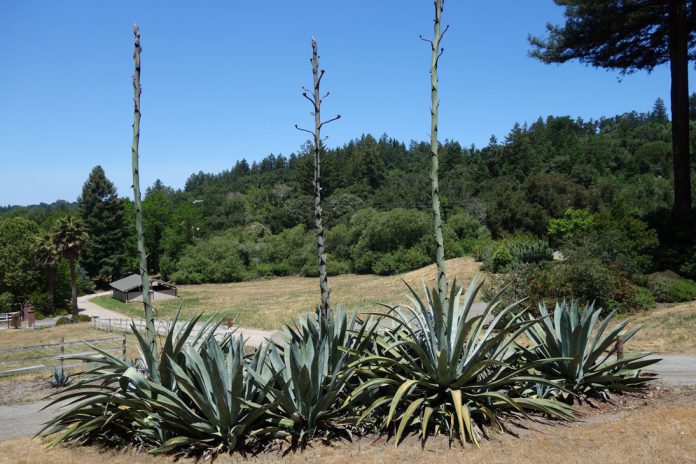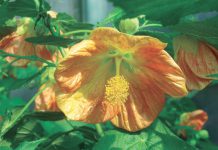
We’ve been told this all our lives, but today’s lesson came from a reader in Scotts Valley who shared a harrowing experience she and her husband had when removing the tall, massive flower spike of their century plant (Agave americana). The birds must have planted it many years ago cause they sure didn’t. But now the plant was massive with a flowering spike loved by the bees. It was time for it to go. So they donned gardening clothes and got out the implements of destruction. That’s when it all went terribly wrong and they ended up in Urgent Care.
Several months ago I was seeing posts all over the internet of proud owners with their once-in-8-to-30-year century plant 15-foot blooming spikes. After blooming, the spike dies and pups grow at the base of the plant to continue the life cycle. The thorns on the tips hurt more than you would expect because of their toxic agents. Calcium oxalate crystals and saponins, which can cause swelling, blisters and other symptoms upon contact or ingestion. The poor folks who ended up in Urgent Care are still on steroids and miserable. Besides being careful around the thorns of this plant, be sure to have some rubbing alcohol on hand to immediately neutralize the toxin.
What other common plants should you watch out for?
Small pets can also be at risk if they ingest parts of poisonous plants out in the yard. Know what plants you have and keep a list. Oleander and foxglove are notorious deadly plants. Here are just some others you might not know.
Hydrangea leaves, flowers and branches contain cyanide. Lantana foliage and especially their unripe berries also contain dangerous toxins, while delphinium leaves and seeds contain toxic alkaloids, which decrease as the plant ages. Sweet peas, lobelia, impatiens, carnations, calla lily, mums and bleeding hearts also have plant parts with some degree of negative effect if ingested.
Surprisingly, even some vegetables contain natural toxins. Diseased celery and green potatoes as well as potato leaves and sprouts produce a very strong toxin. Raw, green, young asparagus shoots can cause dermatitis and the red berries that form on their feathery branches are poisonous. Large quantities of tomato leaves and stems contain alkaloid poisons. Livestock have died from eating the foliage. I guess the deer that browse your tomato vines aren’t ingesting enough to cause them harm as they seem to know just when you have another set of buds for them to nibble.
Trees are not the most common cause of accidental poisonings around the home but a few species may present a hazard.
The black seed inside apples contains cyanide, although you have to eat large quantities for them to be deadly. Peach kernels, bark and twigs contain cyanide also, as do apricot, cherry and plum pits.
Many of us are including native plants in our landscapes to attract wildlife and save water and resources. Here are some common native plants that you should be aware of if you have small children. The following plants have toxic parts: Coffeeberry, California buckeye, Western azalea, Elderberry, California buttercup, Berberis, Prunus, California poppy and annual lupine.
You don’t have to eliminate plants around the home that have natural toxins. Humans have lived for centuries around gardens and orchards. Just be prepared by knowing what plants grow on your property.
Jan Nelson, a landscape designer and California-certified nursery professional, will answer questions about gardening in the Santa Cruz Mountains. Email her at ja******@*ol.com, or visit jannelsonlandscapedesign.com.












